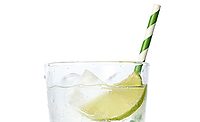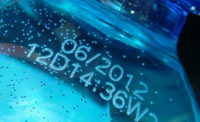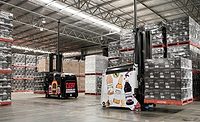Choosing codes, improving production
Special inks, digital solutions deliver goods

Shrinkwrapping and coding of products prior to shipping to retailers is a crucial last step in the process. Domino’s M-Series offers premium label printing with GS1 coding capability to ensure supply chain compliance on all packaging types. (Image courtesy of Domino Amjet)





From high line speeds to condensation, beverage producers operate in a virtually non-stop production cycle that requires up-to-date coding equipment that simultaneously labels, identifies and tracks products – all while keeping pace with ever-changing industry needs.
Experts say that trends impacting SKU proliferation include creating smart, digital codes that improve traceability, easier automation to reduce human error and having flexible equipment to handle packaging substrates and shapes.
“Ever greater production demands means coding equipment has to keep up,” says Chirag Sheth, marketing manager for the Wood Dale, Ill.-based Videojet Technologies Inc. “Outdated coding technology often can’t achieve high quality codes on ultra-fast packaging lines, so beverage manufacturers are looking for smart, digital solutions to improve code quality and add code complexity for supply chain traceability.
“Manufacturers are also choosing codes that don’t detract from the product’s design,” he continues. “For instance, we’ve noticed a shift to more water bottles being marked with lasers instead of inkjet as some manufacturers prefer the ‘clean’ look of laser codes.”
Lightweight packaging and a focus on plastic substrates also is impacting coding technology, according to George Allen, business development manager for the Gurnee, Ill.-based Domino Amjet. “As packaging gets lighter and thinner, it has become imperative that coding technologies are designed to not penetrate the substrate, while ensuring a proper code adheres for longevity with inks, or marks where laser is used,” Allen says.
Beverage production lines today are diverse and include glass and plastic bottles, aluminum cans, flexible pouches, caps, lids, paperboards and ultra light PET containers. Plastic shrink-wrapping, boxes and trays typically require marking and coding solutions as well. Coding technology options of these products usually feature Continuous Inkjet (CIJ), Thermal Inkjet (TIJ) systems or Laser Marking systems, experts say.
Experts also say that the type of coding used on beverages, secondary or tertiary applications depends on the substrate. Laser marking systems deliver high resolution, permanent, non-ink-based printing codes on glass and plastic bottles, cartons, lids, caps, boxes and trays, while fast-drying CIJ meets the needs of many beverage applications including bottles, plastic, aluminum cans and flexible pouches.
Videojet’s Sheth says that lasers work best when using plastics or ultra-lightweight PET containers. “To prevent burn-through on ultra-lightweight PET containers, Videojet introduced a novel modification for its laser coders. A specialized laser tube creates a beam with a wavelength of 9.3µm rather than the conventional 10.6µm, to help avoid deep engraving of the plastic surface,” he says.
“Over the past several years, laser has become more prominent in requests, but it depends on the product,” Allen says. “For example, cans and shrink wrapping are best suited for ink jet, while glass bottles favor laser coding.”
Laser coding is the ideal choice when beverage manufacturer’s require a permanent code, Sheth adds. “Lasers also offer clear, crisp codes with virtually no font, code or graphic restrictions,” he says.
Domino’s lasers are designed to produce high-quality codes even on the highest speed PET and labeling lines, according to Allen. “The i-Tech scan head, combined with unique mirror beam control and optimized cooling, ensures no limitations on performance in any production environment,” he says. “Our Domino D-Series Laser technology can provide industry-leading code quality even at line speeds over 70,000 bottles per hour.”
And when it’s time to pack cartons and cases, Allen recommends the Domino C-Series outer case coding technology because of its versatility to print on most cartons and cases. “It can code up one million cases per ink bottle, while our thermal ink jet, the G-Series, delivers high resolution small text, graphics and bar codes.”
“Videojet has a range of CIJ systems to print on bottles, cans and other beverage containers either before or after filling,” Sheth says. “We offer specially-formulated inks to penetrate surface moisture and help ensure clear codes. We also use yellow and white pigmented inks to provide good contrast on bottles when the beverage is dark.”
Coding control
Both Domino and Videojet are helping customers with more automated methods of job selection, like barcode scanning, to reduce the chance of human error — many times at the touch of a button.
“Domino’s coding technology has been designed to work with all substrates, and our coding automation solutions allow for easy management of the SKU proliferation at the touch of a button,” Allen says. “We ensure compatibility and seamless integration of our equipment and supply many of the leading global beverage manufacturers including Tetra Pak, Sidel and Krones.”
Supply chain compliance
When it comes to solutions for coding on cases and trays, Videojet’s Sheth suggests that labelers and case coding systems be integrated on the conveyer after the sealed case or tray has been discharged. “The type and amount of information printed on cases determines which coding solution is ideal,” he says.
Labeling large pallets also requires coding equipment that is flexible and easy to operate. Domino’s Allen recommends the M-Series premium pallet labeler. He says, “It offers a unique modular design with left and right hand options for easier integration and operation, along with the reassurance of premium code quality pallet label printing with GS1 coding capability for supply chain compliance.”
In addition to engineering equipment that keeps up with elevated line speeds, Videojet Technologies offers easy-to-use interfaces designed to simplify the operator’s choices and reduce errors.
Sheth says, “Our Code Assurance solutions can help simplify operator-to-printer interaction, and better equip operators to achieve the right code on the right product. These solutions also help manufacturers manage an increasing number of codes by using flexible, rules-based coding and network communication.
“Beverage manufacturers are looking to print lot and batch codes, and even supplier-specific information, to allow for quick identification as the product moves through the supply chain,” he continues. “They are also putting more barcodes on trays and cases with tracking and production information.”
On the horizon
As beverage manufacturers seek to engage customers with gaming and promotional give-aways, inkjet codes need to be printed on the underside of caps. This requires precision, Sheth says.“The printers need to be well positioned in order to handle the information flow between the manufacturer’s Enterprise Resource Planning (ERP) system and the printer,” he says.
As demand grows in the beverage community, packaging equipment must continue to innovate and produce. For example, there’s more requests to print onto overwrap film materials, which requires thermal transfer overprinting to handle high integrity coding, Domino’s Allen says.
New packaging substrates and manufacturers’ throughput requirements also will continue to drive new coding technology, according to Videojet’s Sheth.
Communication will continue to be crucial, he says.
“We’re constantly talking to our customers and studying the marketplace to discover packaging trends and production challenges. We’re also keeping an eye on new regulations with specific requirements for code content, clarity, size and placement,” concludes Sheth. “We want to be one of the technology’s leaders.”
Looking for a reprint of this article?
From high-res PDFs to custom plaques, order your copy today!











